| 
Most Norwegian research in the social sciences and humanities is funded by The Research Council of Norway. However, the ministry for which Kjell Erik Øie is a State Secretary, The Ministry for Children and Equality, provides money for gender and sexuality research via The Research Council, or to particular projects. One would hope that the programme for the ministry's big conference “Trygghet og mangfold” (Safety and Diversity) in September 2007 is not indicative of where such money will go in the near future.[13] The conference was held to establish the foundation for a future state policy for gays and lesbians. Kjell Erik Øie and the minister he then served, Karita Bekkemellem, had the last and the first words respectively.[14] The conference raised the same question as we saw Haugli and Lindstad do in Blikk in April 2007: what now, when the law is in place? And who were the keynote researchers whom the State Secretary and the minister had found to help them shed light on this challenge? They were three, and all talked about physical health, mental health, living conditions and quality of life among sexual minorities, based on large survey data. What answer to the “what now?” question is thus left imaginable other than a focus on the health of the homosexual? There was one Norwegian researcher among the three, the quantitative sociologist Bera Ulstein Moseng from the research institute NOVA (Norsk institutt for forskning på oppvekst, velferd og aldring). I will take a brief look at what she has been saying about homosexuals during the better part of the previous decade. |  | 
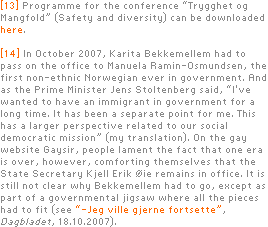
| 
|  |  | In 1999, Moseng was the public figure in the forefront of the project mapping the health and life situation in a sample of the Norwegian gay and lesbian population. It revealed increased use of drugs and alcohol compared to the rest of the population and alarmingly, 25% of the youngest had at least once tried to commit suicide.[15] This was the backdrop of the white paper on gay and lesbian welfare, where the outset for the government was “respect for homophiles and acceptance of the homophile life”, stating, unreflectingly, the fundamental difference between “them” and “us”.[16] Moseng collaborates closely with the ministries as well as with The Norwegian Confederation of Trade Unions (LO). In the national budget for 2008, presented in October 2007, we can, if the Norwegian gay website Gaysir is correct, read that the government will fund with the amount of 2.8 million Norwegian kroner a project that for the second time in less than 10 years maps the health and life situation of gays and lesbians.[17] This is a sequel to the project that established Moseng as the one with competence on gay health (and miseries) in 1999, a project that is also on the priority list for The Association (2006-2008). As will become clear from the following, I will recommend that the government carefully thinks through the theoretical foundation of the new project. |  | 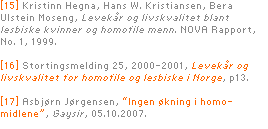
| 
|  |  | Moseng was a co-writer of the article “Sorry, we don't speak queer” which was, as I see it, a shallow presentation and critique of queer theory.[18] And what is Moseng's own message? If you have a stable sexual identity as a homophile, out and proud, you are likely to live a good life, in some ways better than the heterophiles (better economically, more cultural interests, more important friendships). However, if you have, as a homophile, once in your life slept with a person of the opposite gender, you are more likely to abuse drugs, but not only that, you are more likely to have all sorts of somatic and psychic sufferings. She summarises her results like this: |  | 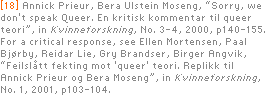
| 
|  |  | A main finding in this drug study is […] that an unambiguous sexual deviance is considerably easier to live with than semi-conformity, i.e. meeting the strong expectations still saturating Norwegian society of having a heterosexual career.[19] |  |  | 
|  |  | The bisexual is in a bad situation, but worst off are those who refuse to belong to a firm identity category. They, in addition, are overrepresented among those who have “self-destructive behaviour regarding unsafe sex, and perhaps, therefore also HIV and AIDS”.[20] 60% of the gay men and 80% of the gay women have had heterosexual encounters in their lifetime (and just to make this explicit: now we are talking about a big majority of the gay population). About them Moseng asks: “Has a group among same-sex sexuals [sammekjønnsseksuelle] been localised who needs preventive health care more than the rest of the homosexual population?”[21] She tentatively answers yes, which is to suggest that most homosexuals are probably in need of preventive health care. It might very well be that the statistics suggesting that gays who once had heterosexual encounters drink too much are correct, but a correlation with the heterosexual activity they once engaged in will have to be spurious. Or let me put it like this: there is in Moseng's work no trace of theoretical reflection that would explain and make it in any way likely that there is a relation between previous heterosexual encounters and your health as a gay-identified person. On the contrary, if there were any relation it would have to be that having had heterosexual experiences would function as health protection, since it is the situation as homophile that otherwise makes you ill. I can go on speculating, since Moseng does not operate with theoretical concepts that would allow her to make intelligible interpretation of the numbers. Moseng's work suffers from a general lack of theoretical reflections, critical questions and discussion. I will return to that. |  | 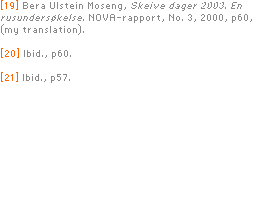
| 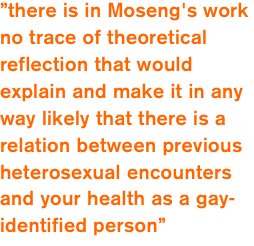
| 
|  |  | 

|  |  |
|